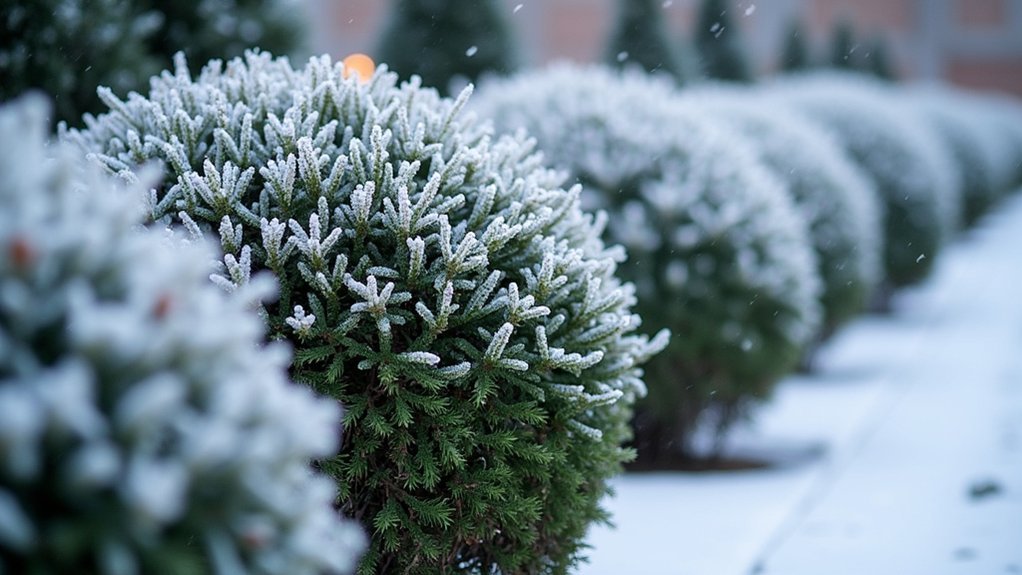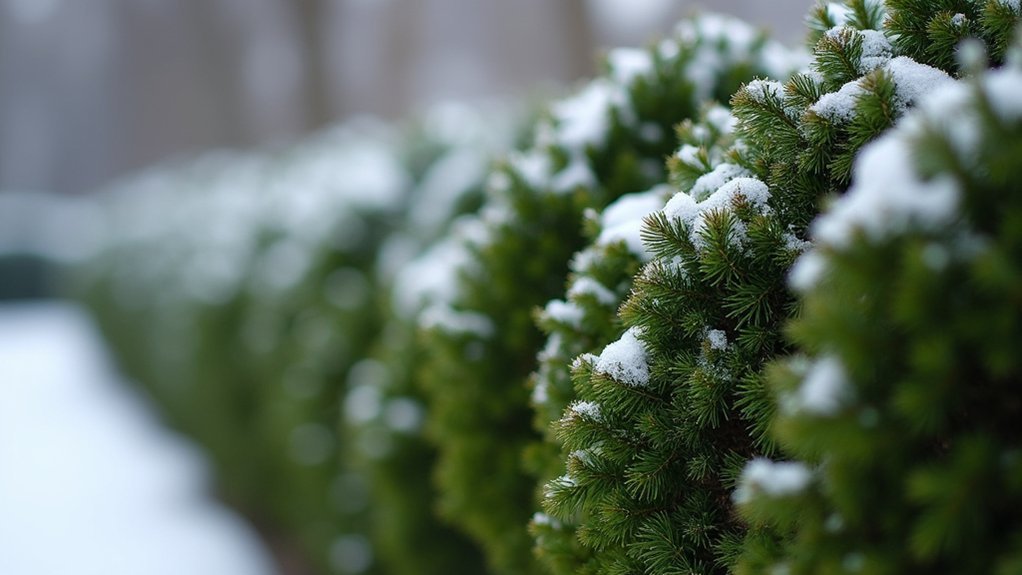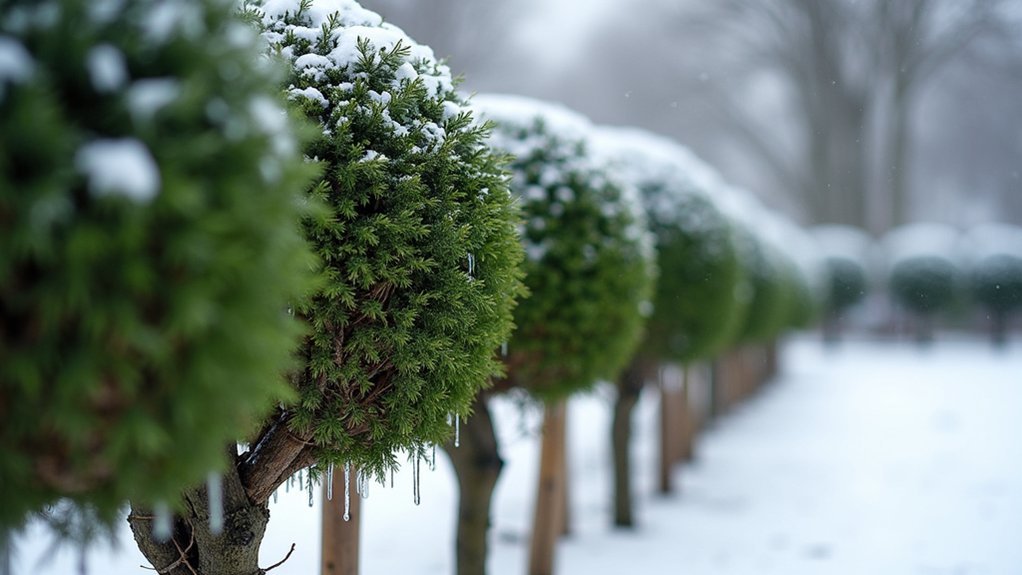To create snow-proof hedges that last, choose cold-hardy varieties suited to your zone and shape them with a tapered profile for natural snow shedding. Prune during dormancy to strengthen branches, apply protective mulch around roots, and install support systems before heavy snowfall. Keep watering consistently through fall, and avoid using harmful de-icing salts near your plants. These seven strategies will transform your winter landscape from vulnerable to vibrant.
Select Cold-Hardy Varieties for Your Climate Zone

When building a snow-resistant hedge, choosing the right plant varieties for your specific climate zone is essential.
Start by determining your USDA hardiness zone using the zone finder tool with your zip code. This will guide your selection of appropriate cold-hardy varieties.
Know your zone before you grow. Research first for cold-hardy hedge selection success.
Coniferous evergreens like Thuja Green Giant, Leyland Cypress, and Emerald Green Arborvitae excel in snowy regions. Their needle structure naturally sheds snow, preventing branch damage.
The Emerald Green Arborvitae stands out for exceptional winter resilience in very cold areas.
Avoid broad-leaved evergreens as they tend to collect snow and ice, increasing breakage risk.
While deciduous hedges lose their leaves in winter, certain varieties can still provide structure and resilience against harsh conditions when properly selected for your specific climate zone.
Shape Hedges With a Tapered Profile for Snow Shedding
Although many gardeners focus primarily on selecting hardy species, proper shaping is equally vital for creating snow-resistant hedges. A tapered profile—wider at the base and narrower at the top—allows heavy snow to slide off naturally rather than accumulating and breaking branches.
This shape also guarantees lower branches receive adequate sunlight while distributing weight effectively.
When pruning for snow resistance:
- Maintain the bottom width approximately 1-2 inches wider than the top to create a natural slope that encourages snow shedding.
- Regularly assess and adjust the taper during growing season to strengthen the hedge’s structure against heavy snow loads.
- Trim gradually to achieve the ideal profile, as drastic reshaping can stress plants and reduce their cold-weather resilience.
Prune During Dormancy to Strengthen Branch Structure

Strategic timing of hedge pruning greatly impacts its ability to withstand winter’s harsh conditions. By choosing to prune during dormancy in early winter, you’ll remove dead or damaged branches while promoting a healthier, more resilient structure.
For deciduous hedges like beech and hazel, winter pruning prevents overgrowth and builds robust branch frameworks that better support heavy snow loads.
Evergreens benefit from pruning before mid-April, just before new growth emerges. Regular dormant-season shaping encourages new, tighter growth patterns that naturally shed snow instead of collecting it.
When pruning, maintain a slight inward angle to create a stronger overall framework. This technique not only improves your hedge’s appearance but markedly enhances its ability to withstand winter’s weight without breaking or splitting.
Apply Protective Mulch to Insulate Root Systems
Three essential layers of protection stand between your hedge’s root system and winter’s fury: soil, mulch, and sometimes snow.
Apply mulch around your hedges in late fall to create a defensive barrier that insulates roots from temperature extremes while maintaining vital soil moisture.
When you apply a thick layer of mulch (2-4 inches) using organic materials like wood chips or shredded leaves, you’re investing in your hedge’s winter survival.
Keep the mulch a few inches away from the stems to prevent rot.
- Timing matters – Apply before the first hard freeze but after the ground cools
- Material choice affects performance – Organic mulches improve soil as they decompose
- Maintenance guarantees protection – Check and replenish throughout winter to maintain proper coverage
Install Support Systems Before Heavy Snowfall

When winter storms approach, your beautiful hedges can quickly become casualties under the crushing weight of wet, heavy snow. To protect your investment, install support systems before the first significant snowfall arrives.
For columnar varieties, wrap biodegradable twine around the plants to prevent branches from splaying outward. If you’re growing broad-leaved evergreens, consider wooden frames or poles that allow effective snow shedding and minimize breakage.
Examine your hedges’ structure and secure appropriate supports that won’t restrict natural growth. Stakes and ties work exceptionally well for individual plants prone to bending under snow load.
Remember to fasten all supports securely while allowing room for the plant to move naturally during winter months. This proactive approach will help your hedges maintain their shape and structural integrity throughout the snowy season.
Maintain Proper Watering Schedules Through Fall
Give your hedges a thorough deep soaking in mid-fall to insulate roots before winter’s freezing temperatures arrive.
Apply 2-4 inches of organic mulch around the base after watering to lock in moisture and regulate soil temperature throughout the cold season.
You’ll want to avoid late-season fertilizing which encourages vulnerable new growth that can’t withstand winter’s harsh conditions.
Pre-Winter Deep Soaking
Although many gardeners focus on spring and summer care, your hedges need attentive watering during fall to survive winter’s harsh conditions.
Pre-winter deep soaking is vital before the ground freezes, providing essential moisture that insulates roots against temperature extremes.
After leaf drop in mid-fall, thoroughly soak the soil around your hedges. This strategic watering helps prevent desiccation of evergreen foliage during winter months when plants can’t access moisture from frozen ground.
- Water deeply but less frequently as temperatures drop, checking soil dryness every two weeks
- Apply a 2-3 inch layer of mulch around hedge bases to enhance moisture retention
- Continue light watering until the ground freezes completely, especially during dry fall seasons
This moisture provision acts as your hedges’ winter insurance policy, protecting their root systems through dormancy.
Mulch Retains Moisture
Properly applied mulch serves as your hedge’s winter survival blanket, creating a protective barrier that locks in critical soil moisture during fall’s changing months.
Apply 2-4 inches of organic mulch around your hedges, keeping it a few inches away from the trunks to prevent rot while still providing essential insulation.
Your mulching strategy works hand-in-hand with your watering routine. Check soil moisture every two weeks throughout fall, providing light watering when dry. This combination guarantees roots remain hydrated before the ground freezes.
Beyond moisture retention, mulch offers additional benefits by suppressing competing weeds and regulating soil temperature.
This dual approach of proper mulching and strategic watering creates the ideal foundation for hedges to withstand winter’s harsh conditions while maintaining their health and vigor.
Avoid Late Fertilizing
While many gardeners focus on year-round nourishment, late-season fertilizing can severely compromise your hedge’s winter hardiness.
To avoid late fertilizing mistakes that leave your plants vulnerable to harsh winter conditions, stop all fertilizer applications by mid-August. Late nutrients stimulate new growth that won’t have time to harden off before frost arrives.
If you’re concerned about winter protection, consider these alternatives:
- Switch to potassium-rich fertilizers in early fall – they strengthen cell walls and improve cold resistance without triggering new growth
- Soak your hedges thoroughly in mid-fall – proper hydration prevents desiccation and browning during winter months
- Apply a 2-3 inch layer of mulch – this maintains soil temperature and moisture without the risks of late fertilizing
Use Plant-Safe Alternatives to De-icing Salt
When winter ice threatens your pathways, swap harmful salt for hedge-friendly alternatives like sand or kitty litter that won’t draw moisture from your plants.
You’ll prevent the browning and potential death of your hedges while still maintaining safe walking surfaces around your property.
Consider installing burlap screens between your hedges and salted areas like roads or driveways to create a protective barrier that shields your greenery from damaging salt exposure.
Salt-Free Snow Management
Traditional de-icing salts pose a serious threat to your carefully maintained hedges, as they leach moisture from plant tissues and can eventually kill your greenery.
Effective salt-free snow management techniques can protect your landscape investment while maintaining safe walkways.
Instead of harmful chemicals, consider these alternatives:
- Sprinkle cat litter or coarse sand on icy paths to provide traction without damaging nearby plants.
- Install burlap screens between walkways and hedges to shield your plants from any salt spray that might come from nearby roads or neighbors’ properties.
- Choose products specifically labeled as “plant-safe” when you absolutely must use a de-icing agent near vegetation.
Regularly check your hedges for signs of salt damage—browning leaves or unusual dieback—especially if they’re situated near areas where salt might accumulate.
Protective Barrier Techniques
Effective protection for your hedges extends beyond simply avoiding salt—it requires creating physical barriers that shield your plants from winter’s harsh elements.
Erect burlap screens along roadside hedges to prevent salt spray from passing vehicles. These screens act as protective shields, greatly reducing the risk of damage from salt-laden runoff.
When you can’t avoid de-icing, choose plant-safe alternatives like calcium magnesium acetate or potassium chloride instead of traditional rock salt.
Always maintain at least a three-foot buffer between any de-icing materials and your hedge root zones to minimize chemical exposure.
Substituting sand or kitty litter for salt provides necessary traction on icy walkways while protecting your hedge investment.
Regular monitoring for early signs of salt damage allows for quick intervention, preserving your hedge’s health and appearance.
Frequently Asked Questions
How Do You Protect Shrubs From Heavy Snow?
You can protect shrubs from heavy snow by knocking off accumulated snow, binding branches with biodegradable twine, pruning for tight shapes, installing burlap screens, and regularly inspecting for damage after snowfalls.
Can Hedges Survive Winter?
Yes, your hedges can survive winter with proper care. Choose cold-hardy species, water deeply before frost, apply mulch around roots, protect from salt damage, and monitor regularly for signs of winter stress.
How Do You Fix Snow Damaged Bushes?
To fix snow-damaged bushes, you’ll need to gently remove snow with a broom, assess damage, prune broken branches back to healthy points, and temporarily tie split branches together. Apply anti-desiccant spray for evergreens.
Should You Remove Heavy Snow From Bushes?
Yes, you should remove heavy snow from bushes promptly to prevent branch damage. Use a broom to gently knock it off before it accumulates excessively. Regular checks after snowfall will protect your plants’ structure.
In Summary
You’ll find that snow-proof hedges aren’t just a seasonal necessity but a year-round investment in your landscape’s beauty. By selecting resilient varieties, maintaining proper shape, and implementing these protective measures, you’ve created hedges that can withstand winter’s worst. Remember, proper fall preparation is your best defense against snow damage. With these strategies, you’ll enjoy robust, healthy hedges regardless of what winter brings.





Leave a Reply